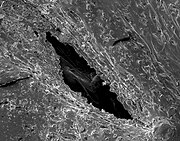This is an old revision of this page, as edited by 203.167.243.202 (talk) at 02:07, 27 March 2012 (Undid revision 484112545 by 203.167.243.202 (talk) accidentally applied--should've been in sandbox). The present address (URL) is a permanent link to this revision, which may differ significantly from the current revision.
Revision as of 02:07, 27 March 2012 by 203.167.243.202 (talk) (Undid revision 484112545 by 203.167.243.202 (talk) accidentally applied--should've been in sandbox)(diff) ← Previous revision | Latest revision (diff) | Newer revision → (diff)
| This article needs additional citations for verification. Please help improve this article by adding citations to reliable sources. Unsourced material may be challenged and removed. Find sources: "Blu Tack" – news · newspapers · books · scholar · JSTOR (April 2011) (Learn how and when to remove this message) |


Blu-Tack is a reusable putty-like pressure-sensitive adhesive produced by Bostik, commonly used to attach lightweight objects (such as posters or sheets of paper) to walls or other dry surfaces. Traditionally pale blue, it is also available in other colours.
The composition of Blu-Tack is a manufacturing secret but is described as a synthetic rubber compound without hazardous properties under normal conditions. It can be swallowed without harm and is noncarcinogenic. It is non-soluble and is denser than water. The material has a flash point of 93°C/200°F, at which it releases carbon dioxide, carbon monoxide, water vapour, oxides of nitrogen, and toxic fumes.
History
In 1970, laboratory researcher Alan Holloway was working for sealant manufacturer Ralli Bondite of Waterlooville, England. Ralli Bondite was a wholly owned subsidiary of G & L Ralli Investment & Trustee Co. Ltd. Holloway inadvertently produced a product that was useless as a sealant, but pliable and semi-elastic. This novelty product was demonstrated by Ralli Bondite management to visiting executives from another sealant and adhesive manufacturer, as a means of wall mounting notices. There was no need for secrecy about the formula, as it was of no use for a gun-grade mastic, the main product of Ralli Bondite. Initially the potential of this material was not fully recognised, but later Bostik commenced research into the development of what they were eventually to launch as Blu-Tack. In its conceptual stage Blu-Tack was white, but was coloured blue in response to concerns received from marketing research regarding the possibility of children mistaking it for edible confectionery.
In the United States during March 2008, Blu-Tack changed color for the first time since 1971 – to pink – to help raise money for Breast Cancer Campaign. 20,000 numbered packs were made available, 10% from each pack going to the charity. The formulation was slightly altered to retain complete consistency with its blue counterpart. Since then, many coloured variations have been made, including red and white, and a green Halloween pack.
Similar products
In South Africa Blu-Tack is commonly known as "Prestik" (as made by Bostik), or "Sticky Stuff" (as made by Pritt). In Iceland it is known as "kennaratyggjó" which translates as "teacher's chewing gum".
Similar products from other manufacturers include "Tack-it" by Faber-Castell,"Buddies" (colored pink), "Pritt-Tack", "Poster Putty", "Tac 'N Stick", "Ticky Tack", "Sticky Tack" and "White Tack" by German company UHU.
In the US, a similar, competing product in an orange color is marketed under the brand "Elmer's Tack". In Italy and France a similar product is Patafix by UHU.
Uses
Like all poster putties, Blu-Tack provides an alternative to the artist's traditional kneaded eraser, having a superior grip and plasticity. Blu-Tack can be finely shaped and worked into even very small areas. Like kneaded erasers, it can be stretched and kneaded to freshen its working surfaces.
Blu-Tack is also used for sculpture. In 2007 artist Elizabeth Thompson created a 200 kilogram sculpture of a house spider using Blu-Tack over a wire frame. It took around 4000 packs and was exhibited at London Zoo. Other artists have created works from the material including stop-motion animation.
Blu-Tack can also be used to pick up and transfer images from printed cartoons.
References
- ^ "Blu-Tack". H2G2. Retrieved 27 January 2012.
- "Blu Tack and how it is made". Frequently Asked Questions. Bostik Australia. 2005. Archived from the original on 2005-12-10. Retrieved 2006-01-10.
- "Daily Express | UK News :: Blu-Tack goes pink for charity". Express.co.uk. 2008-03-04. Retrieved 2009-07-28.
- By tulpastudios Elizabeth Thompson+ Add Contact. "Elizabeth Thompson Blu tack spider | Flickr - Photo Sharing!". Flickr. Retrieved 2012-01-31.